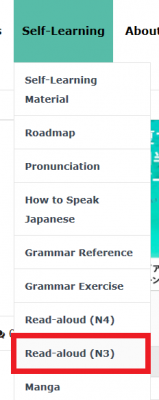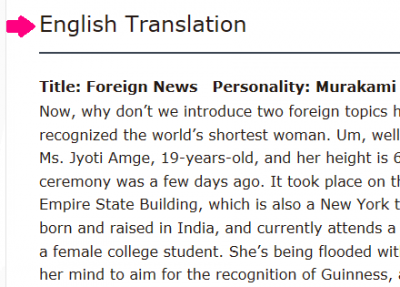They provide recited materials in collaboration with the radio station, FM Shimabara.
Use radio podcasts designed as teaching materials to learn practical Japanese.
- The podcasts can be played at slow speed to suit the recitation or with pauses as necessary.
- There are four types of audio files, which can all be downloaded for free.
- The Japanese scripts all come with furigana [phonetics].
- The scripts have English translations as well as English explanations in areas such as difficult expressions and onomatopoeia.
- Specific oral reading methods for self-learning are also offered.
How to...
Go to the Wasabi Homepage and choose "Read-aloud (N3)" from the "Self-Learning" menu.
"Japanese Radio Podcasts with Read-Aloud Method” is displayed.
You can find the lesson under the "Program Table of Japanese Lessons" in the center of the page.
A variety of topics are covered, ranging from weather to cultural activities, foreign news and Japanese economics.
Unlike a textbook, a radio personality speaks colloquial Japanese, which is more common and offers you practice in practical listening and conversation.
Let's take a look at foreign news “Program 5 Foreign News”, for example.
First, we choose the four types of audio files (Slow speed, Slow speed with pauses, Natural speed, and Natural speed with pauses) . If you are repeating for the first time, it might be best to choose “Slow speed with pauses”.
Under each lesson, you will find the sections, Japanese Script and English Translation.
The Japanese script will show the readings for all characters other than hiragana and katakana, in furigana.
Once you have taken a look through the Japanese script, you can check the English translation to make sure that you have understood the content.
To find how to practice reading aloud, look under "Material Information" and find "How to Use: Read-Aloud Method" at the bottom, where you can check specific ways to read as well as how to proceed.
The Read-Aloud Method is clearly explained.
If you want to save the podcast, you can download it for free from the "Download Links" at the bottom of the page.
There are four types of audio files to choose from, to suit your practice method and level: A. Slow speed, B. Slow speed with pauses, C. Natural speed, and D. Natural speed with pauses.
In addition to reading aloud, this site also has various worksheets for practice.
Go to "Wasabi Lessons“ and choose "Lesson Worksheets".
This site was introduced on our eな Information Station.












